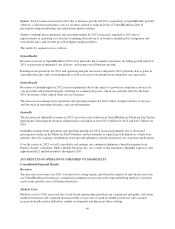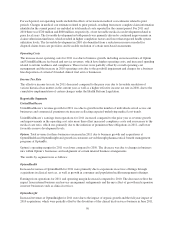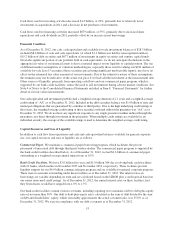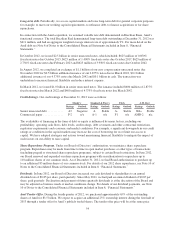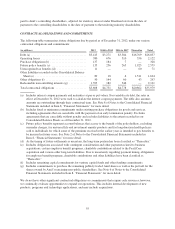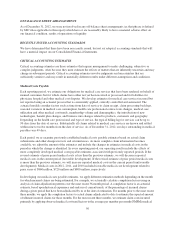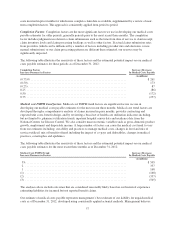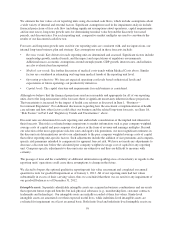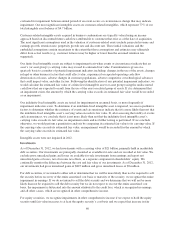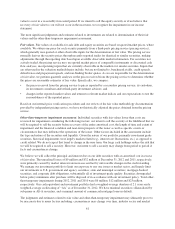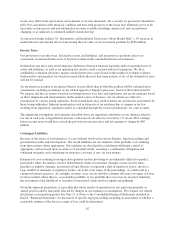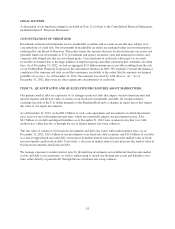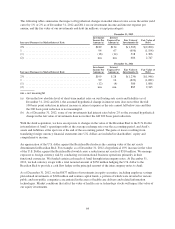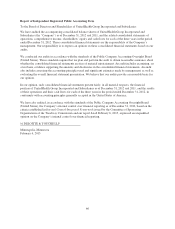United Healthcare 2012 Annual Report Download - page 58
Download and view the complete annual report
Please find page 58 of the 2012 United Healthcare annual report below. You can navigate through the pages in the report by either clicking on the pages listed below, or by using the keyword search tool below to find specific information within the annual report.OFF-BALANCE SHEET ARRANGEMENTS
As of December 31, 2012, we were not involved in any off-balance sheet arrangements (as that phrase is defined
by SEC rules applicable to this report) which have or are reasonably likely to have a material adverse effect on
our financial condition, results of operations or liquidity.
RECENTLY ISSUED ACCOUNTING STANDARDS
We have determined that there have been no recently issued, but not yet adopted, accounting standards that will
have a material impact on our Consolidated Financial Statements.
CRITICAL ACCOUNTING ESTIMATES
Critical accounting estimates are those estimates that require management to make challenging, subjective or
complex judgments, often because they must estimate the effects of matters that are inherently uncertain and may
change in subsequent periods. Critical accounting estimates involve judgments and uncertainties that are
sufficiently sensitive and may result in materially different results under different assumptions and conditions.
Medical Costs Payable
Each reporting period, we estimate our obligations for medical care services that have been rendered on behalf of
insured consumers but for which claims have either not yet been received or processed and for liabilities for
physician, hospital and other medical cost disputes. We develop estimates for medical care services incurred but
not reported using an actuarial process that is consistently applied, centrally controlled and automated. The
actuarial models consider factors such as time from date of service to claim receipt, claim processing backlogs,
seasonal variances in medical care consumption, health care professional contract rate changes, medical care
utilization and other medical cost trends, membership volume and demographics, the introduction of new
technologies, benefit plan changes, and business mix changes related to products, customers and geography.
Depending on the health care professional and type of service, the typical billing lag for services can be up to
90 days from the date of service. Substantially all claims related to medical care services are known and settled
within nine to twelve months from the date of service. As of December 31, 2012, our days outstanding in medical
payables was 49 days.
Each period, we re-examine previously established medical costs payable estimates based on actual claim
submissions and other changes in facts and circumstances. As more complete claim information becomes
available, we adjust the amount of the estimates and include the changes in estimates in medical costs in the
period in which the change is identified. In every reporting period, our operating results include the effects of
more completely developed medical costs payable estimates associated with previously reported periods. If the
revised estimate of prior period medical costs is less than the previous estimate, we will decrease reported
medical costs in the current period (favorable development). If the revised estimate of prior period medical costs
is more than the previous estimate, we will increase reported medical costs in the current period (unfavorable
development). Medical costs in 2012, 2011, and 2010 included favorable medical cost development related to
prior years of $860 million, $720 million and $800 million, respectively.
In developing our medical costs payable estimates, we apply different estimation methods depending on the month
for which incurred claims are being estimated. For example, we actuarially calculate completion factors using an
analysis of claim adjudication patterns over the most recent 36-month period. A completion factor is an actuarial
estimate, based upon historical experience and analysis of current trends, of the percentage of incurred claims
during a given period that have been adjudicated by us at the date of estimation. For months prior to the most recent
three months, we apply the completion factors to actual claims adjudicated-to-date to estimate the expected amount
of ultimate incurred claims for those months. For the most recent three months, we estimate claim costs incurred
primarily by applying observed medical cost trend factors to the average per member per month (PMPM) medical
56





